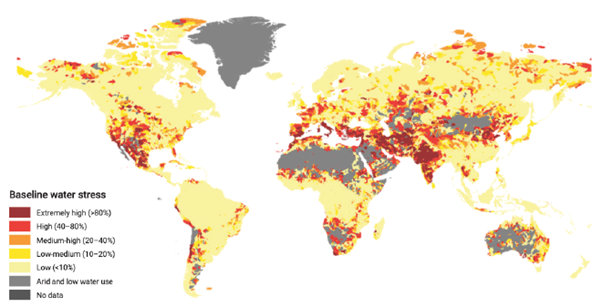The impact of electricity production on water resources
Nour Rteil | Aug. 17, 2023

Image credit: UN, 2020
When thinking of data centres’ environmental impact, energy consumption and carbon footprint often take center stage. But the role of water is equally important, if not more so.
Data centers consume water across two main categories: directly through cooling and indirectly through electricity production and treatment of generated wastewater. The total annual operational water footprint of US data centers in 2018 was estimated at 513 million m3, of which three-fourths is from indirect water dependencies according to this study.
Although innovative cooling technologies, such as direct liquid cooling, evaporative cooling, and advanced heat management solutions, have reduced the direct water consumption of data centers, and this is often captured by the Water Usage Effectiveness (WUE) metric; water consumed during electricity production leaves behind a critical environmental impact and often goes unnoticed.
Freshwater change is one of the nine planetary boundaries which maintain the balance of our ecosystem, and is directly tied to electricity production. Electricity production requires significant volumes of fresh water and has substantial impact on water resources through thermal and chemical pollution. Additionally, in regions facing water scarcity or drought, data centres’ water consumption can contribute to local water stress, affecting both the environment and nearby communities.
Water-Intensive Electricity Generation
Many electricity generation methods rely heavily on water for cooling and other operational processes. According to Mekonnen, these are the most water-intensive electricity sources:
1. Hydropower: Though it is considered a renewable source, the construction of dams and reservoirs for hydropower can disrupt river ecosystems, alter water flow patterns, and even displace communities. According to Mekonnen, hydropower has the second largest water footprint per unit of electricity and heat produced (300 - 850,000 m3 TJe −1) after firewood.
2. Fossil Fuel: Traditional fossil fuel power plants, such as coal, natural gas, and oil, are among the most water-intensive methods of electricity generation. These plants require vast amounts of water for cooling processes, often withdrawing water from nearby rivers, lakes, or oceans. The heated water released back into aquatic ecosystems can have detrimental effects on local biodiversity and water quality.
3. Nuclear Power: While nuclear power plants don’t produce GHG emissions, they rely heavily on water for cooling. The immense heat generated during nuclear fission necessitates intensive cooling, leading to the release of warm water into natural bodies of water. This thermal pollution can disrupt aquatic habitats and alter ecosystem dynamics.
Addressing the Challenge
By transitioning to less water-intensive energy sources, embracing innovation, and promoting water-efficient strategies, data centers can mitigate their water impact.
1. Transitioning to less water-intensive electricity sources: This includes sources such as solar from photovoltaic (PV), wind, and geothermal methods. Although these renewable sources are not sustainable (when considering their life cycle impact), they remain significantly less water-intensive compared to hydropower, fossil fuels, and nuclear power.
N.T. Not all solar sources are less water intensive. According to Mekonnen, the water footprint of solar energy from concentrated solar power (CSP) is in the same order of magnitude as the that from fossil fuels and nuclear energy, because of the need for cooling.
2. Implementing water-efficient practices: This includes water recycling and reuse, particularly for non-potable purposes like cooling or sanitation. As well as exploring rainwater harvesting techniques for various on-site applications.
Assessing the water footprint of electricity is the first step towards adopting sustainable practices. Since most data centers meet their electricity demands from the grid, the geographical location of the data center plays a significant role in its environmental footprint. For example, in most parts of Africa, Latin America and the Caribbean , where hydropower accounts for the larger contribution for electricity, their water footprint is above average. For this reason, the environmental report provided by Interact evaluates the amount of water consumed by the data center for electricity generation, depending on its location. This will ensure comprehensive environmental reporting and contribute to a more sustainable future.